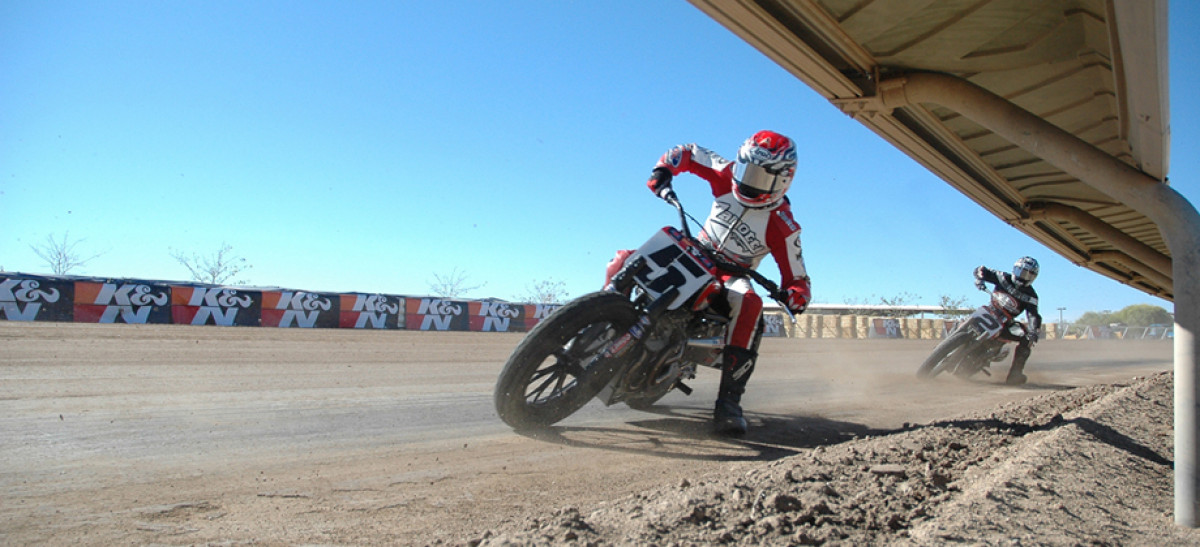
Notes From the Blue Groove: Revenge of the Harleys, Part 2
Revenge of the Harleys, Part 2: A Team Owner's Perspective
 The mile tracks are still dominated by Harley-Davidson XR-750s, and the half-miles are utterly dominated by them. So how is it that a motor designed over 40 years ago stays competitive against far newer engines?
The mile tracks are still dominated by Harley-Davidson XR-750s, and the half-miles are utterly dominated by them. So how is it that a motor designed over 40 years ago stays competitive against far newer engines?
Answering that question involves delving into the very heart of flat track. It's easy to think of power and handling as two separate tuning challenges, but in flat track, the relationship between the way an engine makes power and the way a motorcycle handles are more intimately related. Other motors can, it's true, make more power than an XR-750…. Back in the "Supertrackers" days, it was easy to pull 120 horsepower on a 1,000 cc Suzuki twin. Ironically, however, it wasn't enough to beat the XR. Or, perhaps I should say, it was too much to beat the XR.
Although AMA Pro Racing's technical rules define the Harley-Davidson XR-750 as a built-for-racing motor, it shares its fundamental architecture—its 45-degree V-angle, its air-cooling and pushrods —with almost all current Harley street bikes. The same lopsided firing order that creates the much-loved “potato-potato” idle in the street bikes helps the XR-750 hook up on dirt. The same air cooling and pushrod valve actuation eliminates the need for a radiator and allows the weight of the motor to be concentrated farther forward and lower in the frame.
These “Harley-esque” traits don't just define the look and sound of flat track, they define the look and sound of flat track because despite the threat import brands represent on the track, the XR is still the motor that gets it done. And while mile wins last year by Kawasaki and Ducati prove that getting it done is getting harder, the XRs compete under rules that are literally more restricted, as professional racing’s technical package requires that the Harleys' intakes include a 32mm restrictor plate.
One team that clearly hasn't been too hampered by their bike's storied two-valve, pushrod architecture and those restrictor plates is Zanotti Racing. Their XR-750s were fast enough to win Jake Johnson the championship last year.
Motion Pro is one of Zanotti's sponsors. Motion Pro's Chris Van Andel, who has a keen eye for trick parts, recently told me, "If you take a good, close look at Zanotti's XRs, you'll see they're full of unique components they make themselves." Van Andel raved about the amount of high-tech effort the team's put into extracting as much power out of the Harley twin, while building in as much reliability as possible.
 I didn't expect Dave Zanotti to tell me all (or really any) of his secrets, but I still thought he'd be a good place to start, in terms of learning what it takes to win a championship with a motor that's significantly older than the guy riding the bike. (Note: Read to the bottom to get a hilarious perspective how Dave, as a team owner, thinks of his rider as a stray dog.)
I didn't expect Dave Zanotti to tell me all (or really any) of his secrets, but I still thought he'd be a good place to start, in terms of learning what it takes to win a championship with a motor that's significantly older than the guy riding the bike. (Note: Read to the bottom to get a hilarious perspective how Dave, as a team owner, thinks of his rider as a stray dog.)
In order to get some of the horsepower lost to those restrictor plates back, Zanotti is pushing his XR-750s to higher and higher redlines. The bikes he's building for Jake Johnson, for example, rev at least 1,500 rpm higher than the XR-750s Dave's dad fielded for Steve Eklund back in the '70s.
Dave pays a price to rev those pushrod motors so hard, though: the cases crack around the main bearing journals, and rod bearings (which, brace yourself, cost $1,000 a piece) heat up and fail. Whereas motors used to last a few races between major rebuilds, Zanotti Racing now has to inspect them thoroughly after every race.
There are subtle differences in tuning philosophies among top builders. It seems that the smaller restrictor plates have caused oversized valves to fall out of vogue a little. Compression ratios vary. Dave told me that although he likes to stay in the 10:1-11:1 range, he's heard of people running as high as 14:1. While no one wants to share the intimate details of their XR builds, he did describe Zanotti Racing's approach in general terms. Basically, Dave’s goal is to lighten internals a bit to allow the motor to spin to higher rpm. The trick is doing that in a motor with that dirt-friendly close firing order, without letting the motor shake itself apart. (Remember 'twingles'? Even closer firing orders, even more dirt friendly, but too fragile.)
"I have an environmental company," Dave told me. "But I never stop thinking about the race team. Every day, I'll be driving out to a work site or sitting in a meeting with clients, thinking about tweaking a PVL ignition to get a hotter spark, or trying different exhaust cones.”
Mostly though, Zanotti's preparation philosophy recognizes that to finish first, you have to first finish. "My mechanic is just so finicky," he told me. "If other teams realized how much attention to detail we put into preparing for every race....”
What keeps Zanotti in the Harley-Davidson camp is his conviction that XR-powered bikes still out-handle all their rivals on the track. Dave thinks it's down to the heavy old crankshaft being located so close to the front wheel that bikes can keep weight on the front and steer better through the turns.
 "Other motors probably have 20 more horsepower, but if you can't put it to the ground, it's not going to do you any good," Dave told me. And so, Zanotti Racing will spend thousands of dollars and hundreds of hours preparing Jake's XR-750 for Springfield, where—fingers crossed—it will run just about wide open, non-stop, for 25 miles.
"Other motors probably have 20 more horsepower, but if you can't put it to the ground, it's not going to do you any good," Dave told me. And so, Zanotti Racing will spend thousands of dollars and hundreds of hours preparing Jake's XR-750 for Springfield, where—fingers crossed—it will run just about wide open, non-stop, for 25 miles.
"We put so much time into this," Dave told me as our conversation was coming to a close. "None of us get paid, and maybe that's part of our success. We don't have to do it, we want to do it."
Then he mixed a funny metaphor, making a statement that made me smile and think, “This is why I'm a journalist.”
"When you have a rider that steps up,” Dave told me, “it's like a dog that steps up on your porch. Once you feed it, you have to keep feeding it, because he's going to come back. When someone starts depending on you, you have to follow through. We feel that we have to work to our full potential, because our rider's giving us his full potential."
Finally—and I think he was talking about a race team, but it also applies to that big crate of parts you get from Harley-Davidson when you order a new XR-750 motor—Dave said, "When it all comes together, it's a beautiful thing."
Latest news

EVENT ADVANCE: AFT Singles Ace Drane Makes His Case






























